MILITARY RAILROADS
OF THE NEW YORK METROPOLITAN
AREA:
BROOKLYN NAVY YARD /
NEW YORK NAVAL SHIPYARD
Fort Greene & Williamsburg, Brooklyn
BNY NYNY
.
updated:
|
|
update summary |
date |
| BNY #12 disposition info updated | 27 November 2022 |
.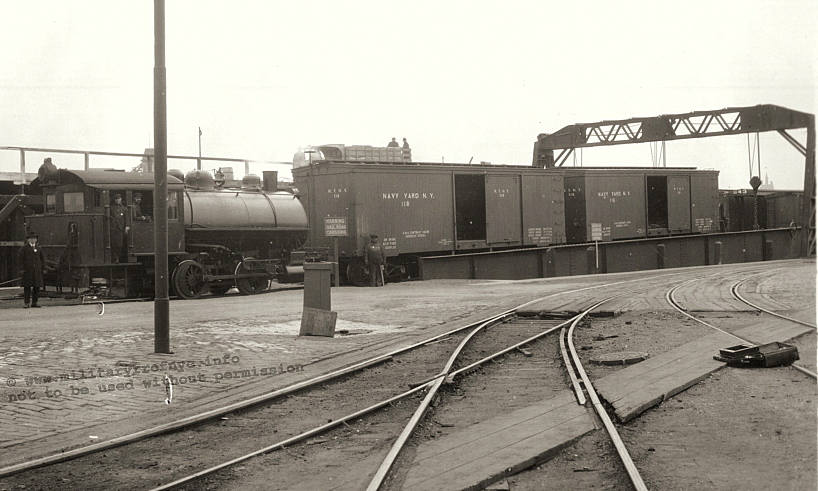
.
.

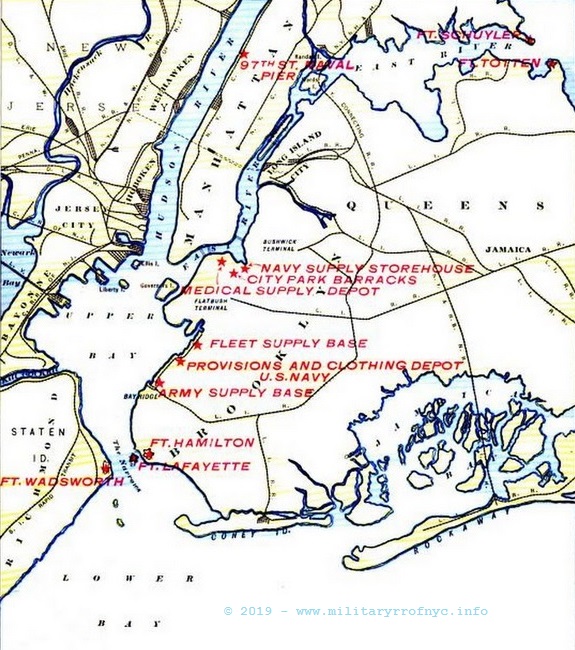
.
.
Overview & History
.
The Brooklyn Navy Yard, the popular and colloquial name for
the New York Naval Shipyard, was organized in 1801 and is located north of
the Manhattan Bridge and in Wallabout Channel at a bend in the East River
and was a United States Government Military Installation (Department of the
Navy / Department of Defense).
A brief maritime history of this installation
includes the construction of Robert Fulton's steam powered frigate "Fulton"
(launched 1815), and the Brooklyn Navy Yard would go on to build several
of the US Navy's most famous and recognizable warships, including but not
limited to the:
.
|
There are many historical and contemporary publications that cover the in-depth history of the Brooklyn Navy Yard, and I will leave it to those books to explain that history. This website will focus upon the rail infrastructure of the Brooklyn Navy Yard.
As for rail traffic, the Brooklyn Navy Yard received ship building supplies and coal as well as general freight via carfloat. It would be responsible not only for the hull construction of a vessel, but all the interior spaces as well, which basically means anything that was required in the construction of those vessels, was brought in.
It should be noted that vessels requiring repair or refit at the Brooklyn Navy Yard, were required to first offload their the munitions prior to entering the Yard. Munitions would be offloaded at Iona Island Naval Ammunition Depot and Earle Naval Ammunition Depot / Naval Weapons Station Earle. Newly commissioned vessels would have their munitions brought on board at these locations prior to sailing for active duty.
Trackage
.
The rail operations of the Brooklyn Navy Yard was sufficiently large and extensive enough to have necessitated the construction of a roundhouse with a turntable. Paul Strubeck located the following photographs on the 'net.
|
... |
|
.
.
By 1916, the Navy Yard comprised over 255 acres, and would come to have over 30 miles of railroad track. It is unknown at this time if included in this figure is the aggregate total of both the 18 foot and 37 foot gauge trackage for the huge cranes that wound there way around the berths and dry docks, or just the standard gauge trackage.
Much of the trackage was within streets and driveways, and therefor flush with ground surface.
Trackage was upgraded and expanded throughout the years as needed, and many images throughout the decades exist of the track work in progress. Perhaps the greatest recordation of images was during World War I and the period prior to the United States' entrance into World War II.
During the World War I expansion, it is seen in images showing dual gauge railroad trackage. It is understood at this time, that only the contract and construction work was performed by the 36" gauge locomotives. The daily operations of the Navy Yard was standard gauge, but do to routing dual gauge was installed.
Due to the limited confines of the dry dock and likewise limited room to build trackage, it now appears that the Shay type locomotives were employed to haul the dump cars from the bottom of the dry dock excavation pits via a set of switchbacks to the surface, where regular saddletank locomotives would shuttle those dump cars from the excavation pit to the scow trestle at Wallabout Basin for dumping into scows, as seen in the image below.
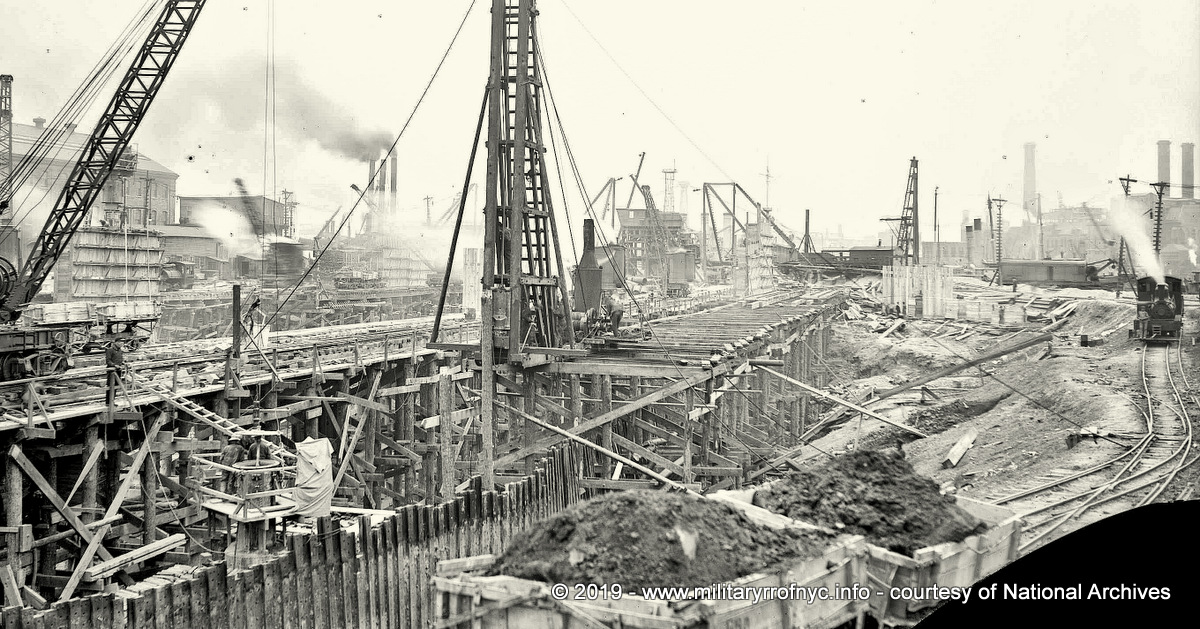
April 10, 1910
Excavation of Dry Dock #4.
courtesy of National Archives
via G. Lane
.
.
Prior to and following the entrance of the United States into World War II, found the Brooklyn Navy Yard on yet another large scale expansion project.
|
| .
. |
|
| .
. |
|
| .
. |
|
.
.
In addition to this open air trackage, many buildings were equipped with indoor rail service:
|
| .
. |
|
.
Tom Flagg, graciously allowed the use of the following images ascertained from his research.
The first appears to be facility map from 1938. This map is significant as it shows the layout of the Navy Yard and trackage prior to the Navy Yards expansion into the Wallabout Terminal and the original location of the float bridge. Clicking on the map below will take you to a large scan. Please note: Use your back arrow to return you here.

1938
courtesy of T. Flagg
added 08 May
2009
.
.

Facility Map, New York Navy Yard - June 30, 1939
(click on the map for a large size
graphic)
courtesy of Brooklyn Navy Yard Archives
added 02 August 2019
.
.
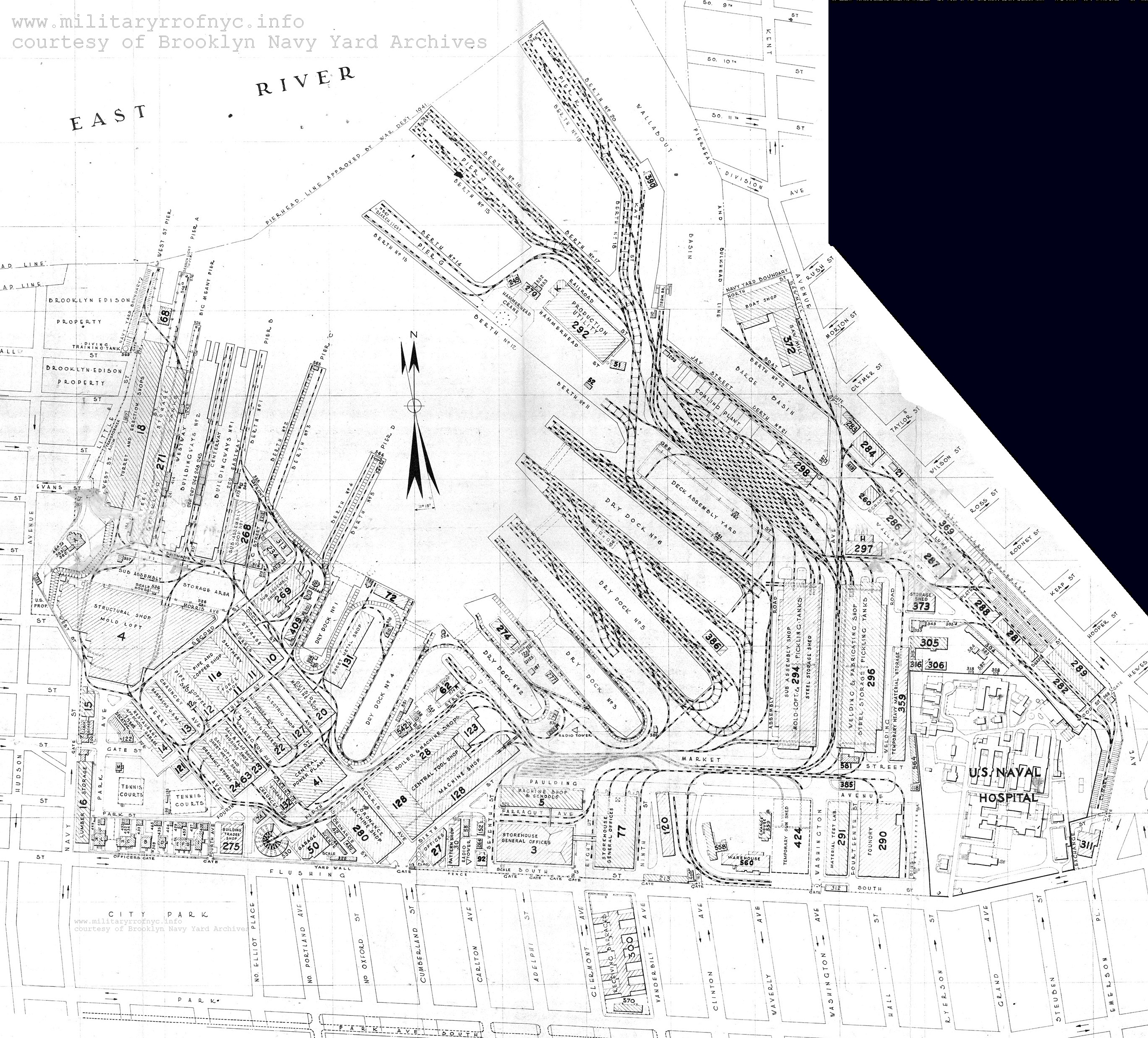
Facility Map, New York Navy Yard - 1943
(click on the map for a large size
graphic)
courtesy of Brooklyn Navy Yard Archives
added 02 August 2019
.
.
This next image is a Facility Map of the New York Naval Shipyard dated 1961. Again, please click on the map for a large size graphic with the corresponding key for the building numbers.
.
.
.
This next image, is an excerpt from an inspection report and map performed on the the infrastructure within the Navy Yard. This map better shows the relationship of the Brooklyn Navy Yard float bridge to the Brooklyn Eastern District Terminal float bridge, and the interim track connection installed to interchange between the two.
.
Again, click on the image for a large scale scan. Use the back arrow on your browser to return you here.
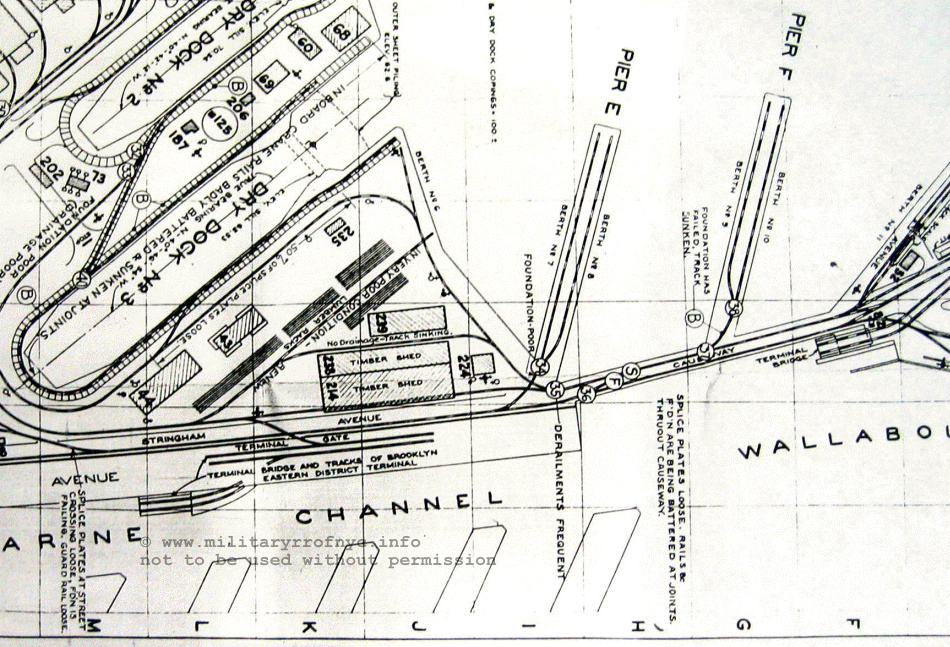
1940
courtesy of T. Flagg
added 08 May 2009
.
.
The following image shows the "Terminal Gate" and track accessing the Brooklyn Eastern District Terminal trackage from inside the Navy Yard. The smokestacks are of the Brooklyn Rapid Transit Power Generating Station.

April 21, 1936 - Stringham Avenue (BNY) / Clinton Avenue (CoNY) Gate
for access to the Brooklyn Navy Yard as part of the City of New York City
contract to
Brooklyn Eastern District Terminal for service to the Wallabout Market
Terminal.
Brooklyn Navy Yard Development Corp.
archives
added 11 March 2012
.
.
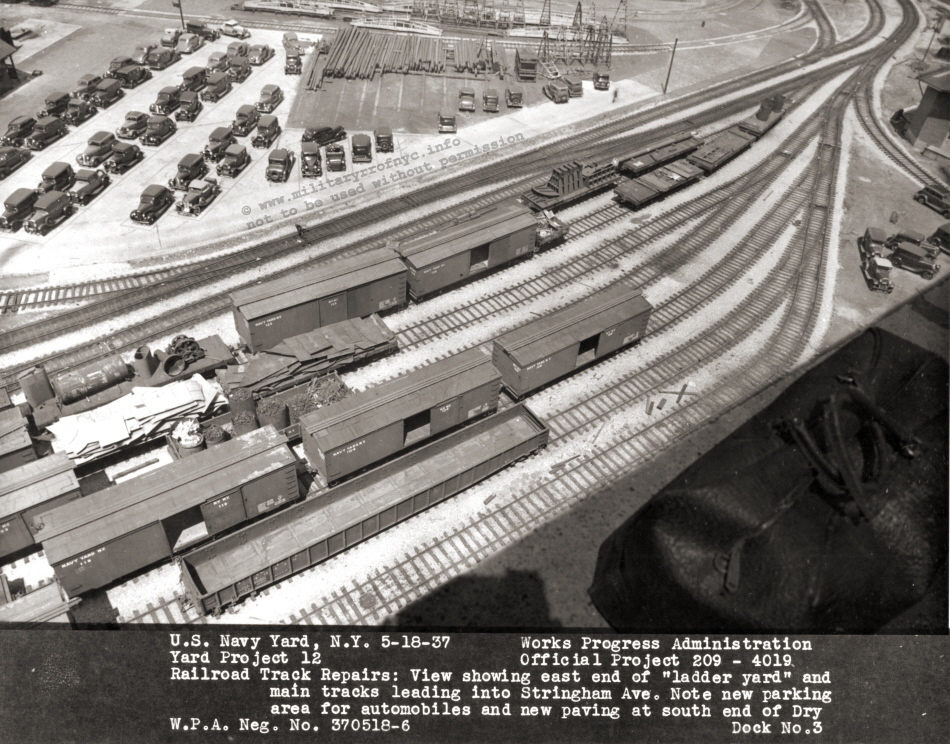
May 18, 1937
photo courtesy of National Archives
via C. Marshall
added 18 February 2014
.
.
Speaking of the Brooklyn Eastern District Terminal, the US Government would contract with the BEDT to transport carfloats to and from the Navy Yard property after 1940-41, however the Brooklyn Navy Yard would have their own switchers execute switching and car movements within the Navy Yard. Eventually, the BEDT would also go on to take over rail operations within the Navy Yard in the mid 1960's (possibly 1966 when the Brooklyn Navy Yard was transferred from military control to civilian ownership).
For more information on the BEDT's float bridge operation and contract with the City of New York, please click here:
| Brooklyn Eastern District Terminal - Wallabout Market Terminal |
.
Float Bridges
.
The first float bridge installed at the Brooklyn Navy Yard, was a pontoon supported pony truss with overhead support gantry. The trestle at right, is for the direct dumping of loose excavation material (sand, stone, etc) into scows for removal.
The following image, courtesy of Tom Flagg, shows the pontoon through plate girder float bridge as it appeared in 1916:
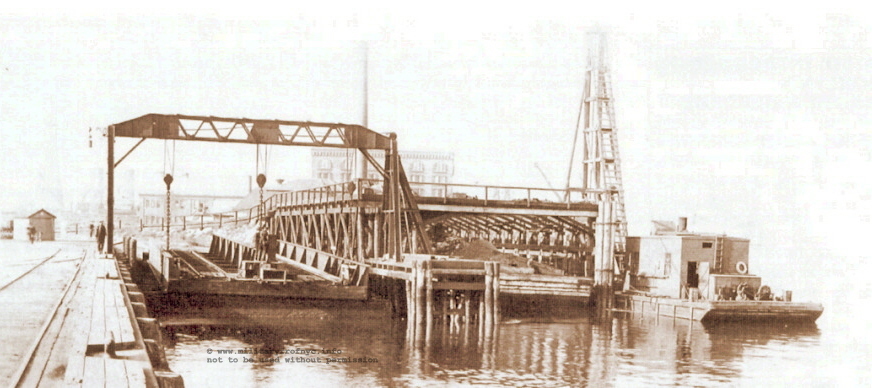
Brooklyn Navy Yard float bridge - 1916
National Archives
T. Flagg collection
added 07 May 2009
The Brooklyn Eastern District Terminal would install a float bridge of their own to serve their Wallabout Market Terminal, but this float bridge was not located on, but adjacent to the Brooklyn Navy Yard on Clinton Avenue. For more information on this operation click here.
The second Brooklyn Navy Yard floatbridge, would been installed circa 1941 upon the completion of the Wallabout Basin expansion. This type was an electrically powered overhead suspension "French Patent" / contained apron type seen below:
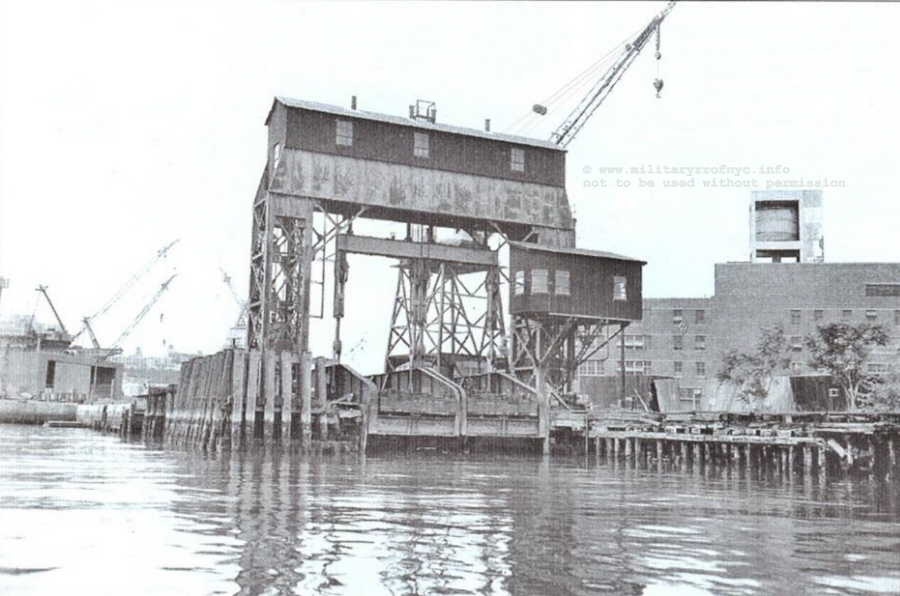
1977
T. Flagg photo
added 07 May
2009
This float bridge was modified somewhat in 1983, when the overhead supported dual spans seen in the image above were replaced with a pontoon supported float bridge. Actually, there were two pontoon supported float bridges installed.
The first pontoon supported float bridge was a through plate girder type, believed to have been floated over from the Delaware, Lackawanna & Western Railroad's Hoboken, NJ facility. However, this float bridge developed an as yet undetermined conflict before being use, necessitating a replacement. It is understood, that the float bridge or pontoon was too wide to between the gantry foundations, but this is unconfirmed.
The second pontoon supported float bridge,
a pony truss would be installed instead, and the plate girder would be abandoned
next to the bulkhead to the left. This pony truss float bridge was taken
from the Brooklyn Eastern District Terminal's North 9th Street location,
following the closure of that facility in August
1983.
.
| This float bridge was last used in
1995 by New York Cross Harbor RR for a subway car rebuilder that located
to the Navy Yard.
The pony truss float bridge remains in place at this location to this day, although the decking is mostly destroyed, and the pontoon is no longer buoyant. It should be noted that neither of the pontoon supported float bridge required overhead suspension, and therefore the cables were never attached, but the overhead gantry was left standing, Also, these pontoon supported float bridges were installed after the Brooklyn Navy Yard was no longer under military control and relinquished to civilian ownership. |
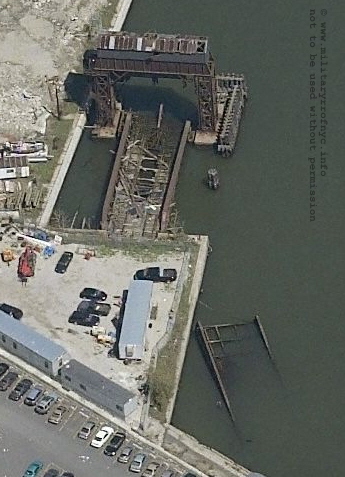 |
|
|
(looking west) |
(looking north) |
John McCluskey took extensive images of the Brooklyn Navy Yard gantry and pony truss replacement spans, and they maybe seen here:
Structure
713 - Brooklyn Navy Yard photo album |
Freight Cars
.
In referencing images from the Brooklyn Navy Yard, we can see they fielded a modest roster of freight cars. So far through images, we have been able to confirm the existence of:
Eight wheel 40'(?) box cars #118 and #116 (numbering in the 100 series)

April 2, 1919
photo courtesy of National Archives
via C. Marshall
added 18 February 2014
.
.
Eight wheel 36'(?) flat cars road numbers #244 (numbering in the 200 series)
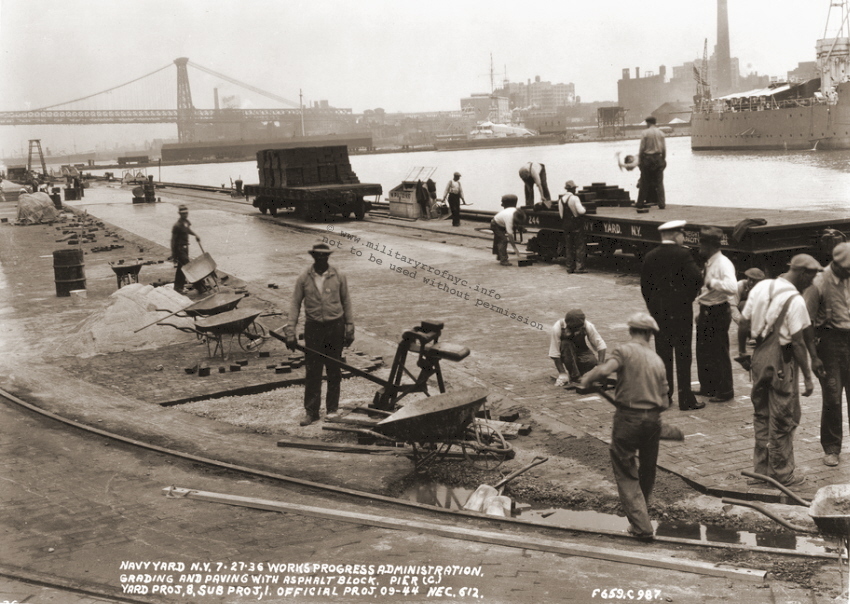
Brooklyn Navy Yard Development Corp.
archives
added 11 March 2012
.
.
Four wheel, four cubic yard dump cars #388 & #378 (numbering in the 300
series)
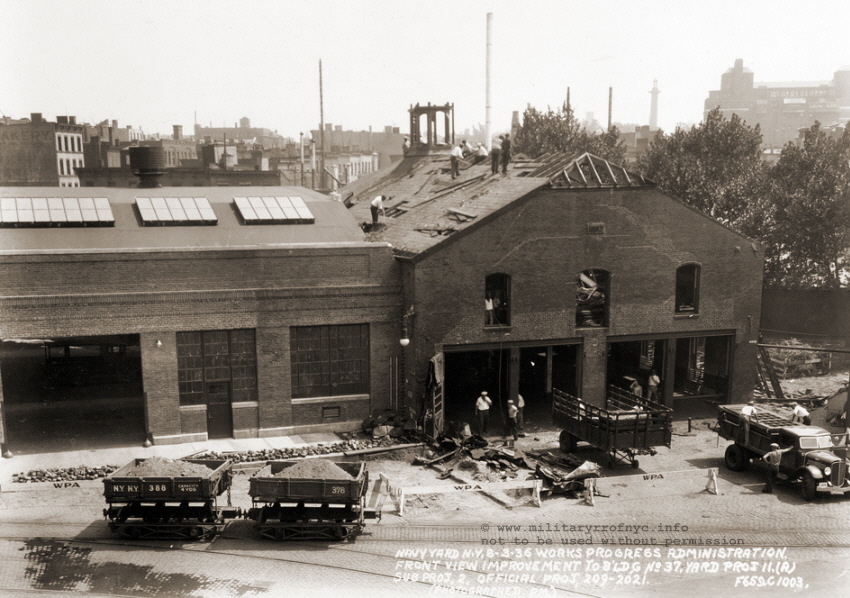
Brooklyn Navy Yard Development Corp.
archives
added 11 March 2012
.
.
In October 2013, I received an email from Chip Marshall, who was kind enough to forward several images located in the National Archives, College Park, MD. One of which is Crane #21 lifting a deck gun in 1919!

Derrick # 21 - April 2, 1919
photo courtesy of National Archives
via C. Marshall
added 18 February 2014
Locomotives
.
The Brooklyn Navy Yard would come to own many steam locomotives throughout it's history of several different configurations. The earliest locomotives appear to have been purchased second hand from the New York Elevated Railway, with new locomotives purchased through normal government contracts around 1900.
It had been discovered in Lima Locomotive Company builders records that this author has obtained, that the Brooklyn Navy Yard at one time; operated a 2 Truck, 25 Ton Shay. Many unanswered questions abounded about this locomotive, such as what was the need for a Navy Yard to need a Shay type locomotive.
In 2019, in photos located by George Lane and held by the National Archives (which can be seen below), shows at least TWO Shay type locomotives. One of which was documented to have worked at Brooklyn Navy Yard, and now yet another. A cursory review of the Lima Builders Records failed to note the history of the that second Shay.
However, engaging upon in-depth research has revealed that these Shay locomotives were almost certainly not actually part of the Brooklyn Navy Yard locomotive roster, but were in fact purchased by the construction contractor awarded the contract for the Navy Yard expansion during the 1910's, that being Holbrook, Cabot & Rollins. When searching the Lima build records by that name, three identical 36" gauge 24 ton 2 truck Shay locomotive were built within 1 month of each other for Holbrook, Cabot & Rollins. Only one of which was earmarked for Brooklyn Navy Yard. It is now believed the Shay locomotives in the National Archives images, despite being seen at the Brooklyn Navy Yard in fact belong to Holbrook, Cabot & Rollins.
It is hypothesized by the author, that the Shays and their excellent traction, were necessary to drag the spoil dump cars up the steep embankment out of the excavation pit(s) for the new dry dock construction. Once topside on the surface, the conventional 0-4-0T could take the dump cars to the scow dump trestle in Wallabout Basin, next to the transfer bridge.
Another clue to this conclusion of the Shays being Holbrook owned, is that at least one of the Vulcan 36" gauge 0-4-0T attributed to the Brooklyn Navy Yard is also shown to have been ordered by Holbrook, Cabot & Rollins. Therefore, this author has now come to the conclusion that most, if not all; narrow gauge locomotive and equipment was purchased and fielded by the contractors, and not the US Navy per se.
This conclusion seems to also be borne out by the entry of Vulcan c/n 2822 36" gauge built in September 1918. This entry turns out to be the last narrow gauge locomotive shown attributed to the Brooklyn Navy Yard. As it is well documented, the WWI expansion of the Navy Yard concluded a few months later. All other locomotives after this one, are standard gauge.
This would also explain the dual gauge trackage that is readily seen in that series of construction photos at the National Archives:
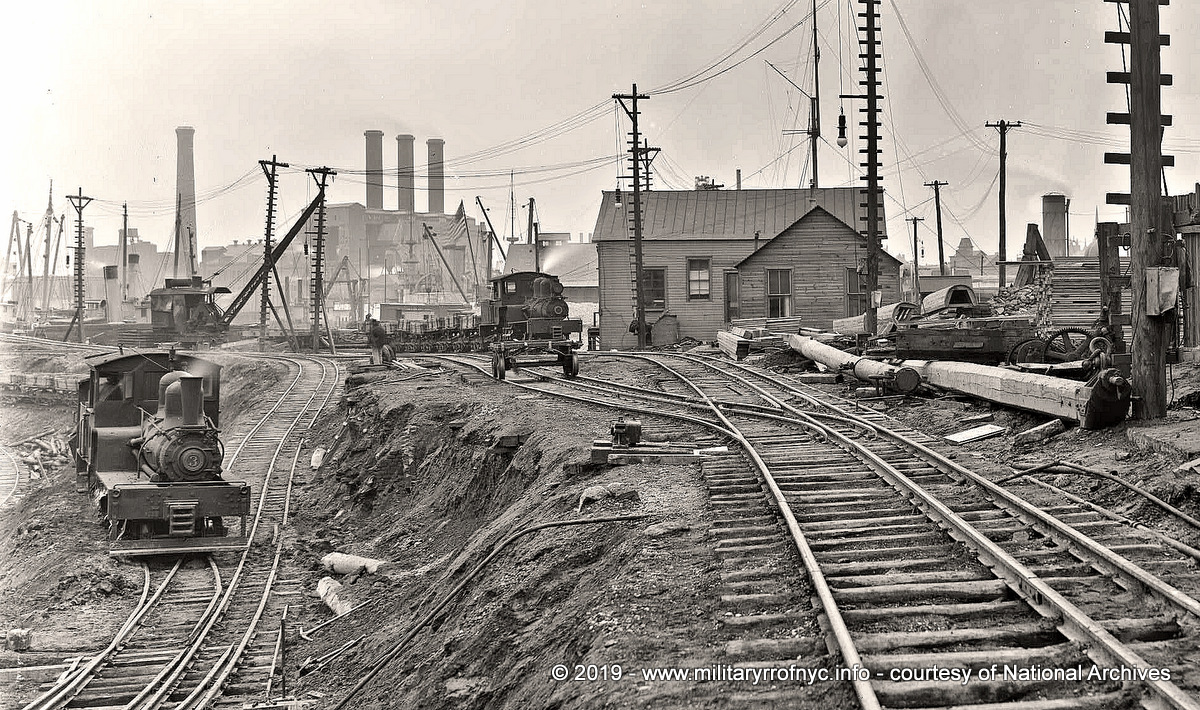
Holbrook Cabot & Rollins #3 & unknown (#1?) - Feb. 27, 1910
Excavation of Dry Dock #4. It is believed the Shays with their
greater tractive effort on steep grades of switchbacks worked the excavation pits hauling the spoil dump cars up to the surface
while conventional locomotives were used on the level surface.
Looking northeast - Brooklyn Rapid Transit Powerhouse smokestacks in background
courtesy National Archives
via G. Lane
added 01 Aug 2019
.
unknown Shay locomotive - Apr. 29, 1910
Excavation of Dry Dock No. 4
It is believed the Shays with their
greater tractive effort on steep grades worked the excavation pits hauling the spoil dump cars,
while other conventional locomotives were used on the level surface.
Looking
north - Williamsburg Bridge towers can be discerned in background.
Brooklyn Rapid Transit Powerhouse smokestacks on right edge.
courtesy National Archives
via G. Lane
added 01 Aug 2019
.
.

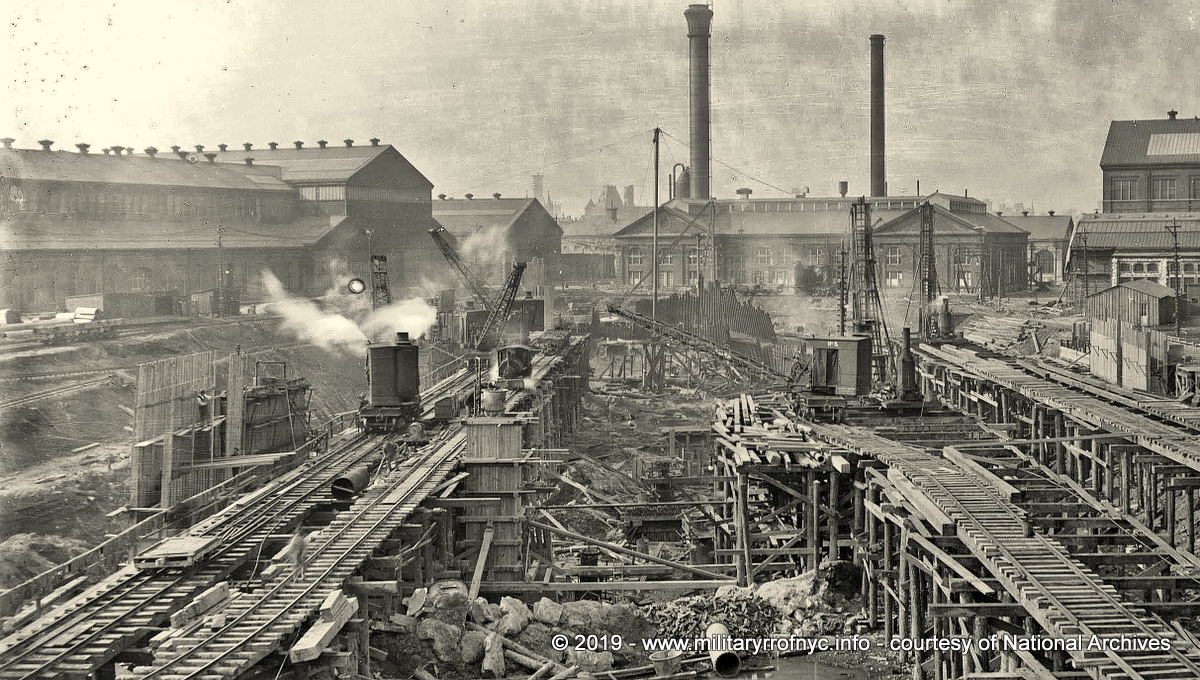
indeterminate narrow gauge 0-4-0T (believed to be Holbrook, Cabot & Rollins Davenport c/n 499 or c/n 1014 - 1910
Excavation for Dry Dock 4. Note dual and narrow gauge trackage, and the switchback trackage on left edge on image.
Looking south.
courtesy National Archives
via G. Lane
added 01 Aug 2019
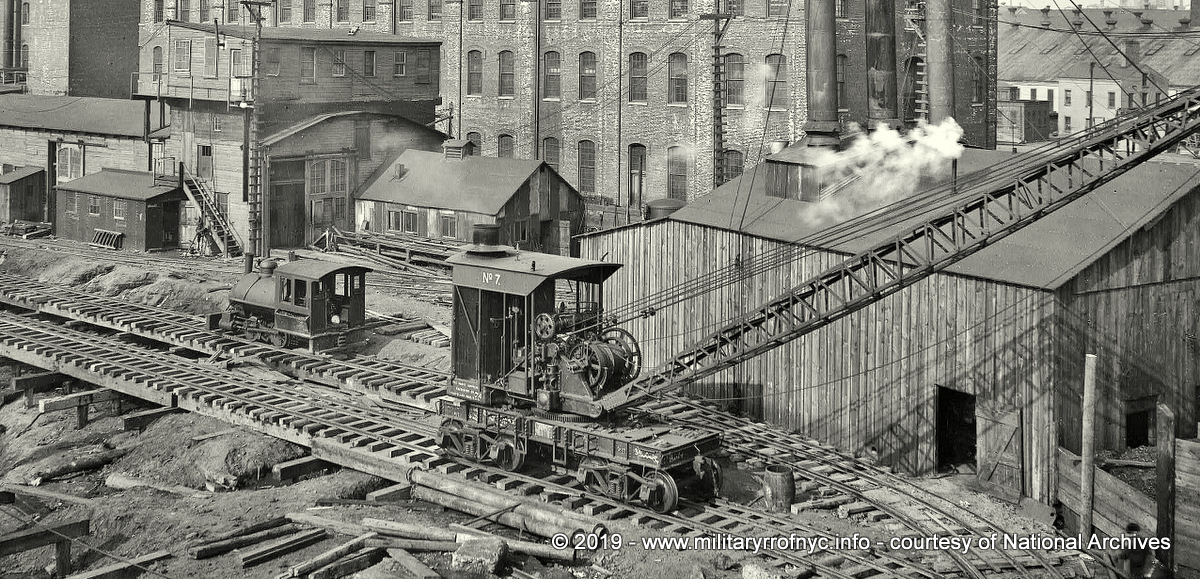
indeterminate narrow gauge 0-4-0T (believed to be Holbrook, Cabot & Rollins Davenport c/n 499 or c/n 1014 - March 27, 1910
Excavation of Dry Dock #4.
Note the standard gauge derrick with MCB coupler.
courtesy National Archives
via G. Lane
added 01 Aug 2019
.
.
Returning to the actual roster of locomotives that were assigned to the Brooklyn Navy Yard would come to operate steam locomotives constructed by many manufacturers: Rhode Island, Vulcan, H. K. Porter and American Locomotive.
The Brooklyn Navy Yard would dieselize their operations in 1940 through 1944, with the procurement of Vulcan, Atlas and Whitcomb locomotives during those years. The Atlas locomotives would be surplused in 1948, as would the Whitcombs, being shipped to the Naval Supply Depot in Bayonne, NJ; where they would be put up for sale. Several were purchased by private owners for industrial line use. The Vulcan locomotive which was jack shaft driven, would be used by Lionel as a prototype for an O scale version of this locomotive!
From 1968 through 1981, after the Brooklyn Navy Yard was released from military control; this location would be home to Seatrain Shipbuilding, (see that page on Seatrain Shipbuilding here), which operated General Electric 44 ton locomotives on a portion of the Brooklyn Navy Yard Trackage, and utilized the float bridge.
As for the other locomotives listed, unless otherwise stated, their disposition in unknown at this time.
As far as it is known only two of the Brooklyn Navy Yard steam locomotives have survived: #7 and #12. BNY #7 which after serving for the Navy Yard; was employed by American Creosote as their #7 as well. This locomotive is currently under restoration at the Illinois Railroad Museum shops located in Union, Illinois.
BNY #12 which has been cosmetically restored, currently resides at the Rochester & Genesee Valley Railroad Museum in New York.
|
|||||||||||||||||||||||||||||||||||||||||||||||||||||||||
| .
. | |||||||||||||||||||||||||||||||||||||||||||||||||||||||||
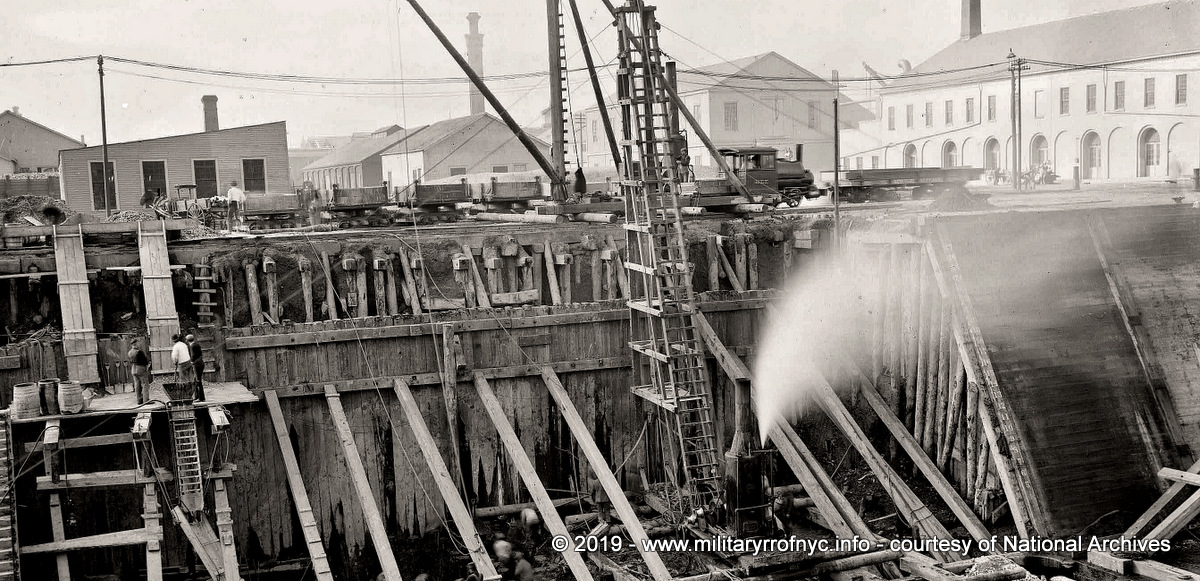 v vNYNY "Bee" - undated "Brooklyn Navy Yard locomotive working at Dry Dock No. 2" courtesy National Archives via G. Lane added 01 Aug 2019 | |||||||||||||||||||||||||||||||||||||||||||||||||||||||||
| .
. | |||||||||||||||||||||||||||||||||||||||||||||||||||||||||
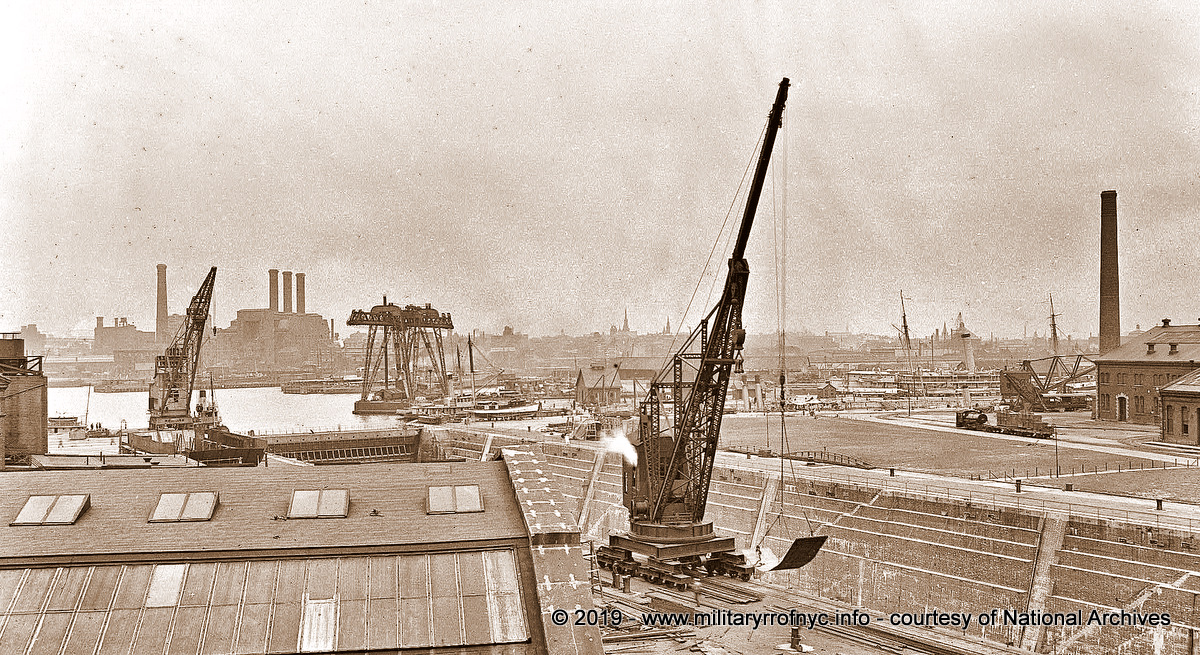 NYNY #1 - June 1914 newly completed Dry Dock #4 courtesy National Archives via G. Lane added 01 Aug 2019 | |||||||||||||||||||||||||||||||||||||||||||||||||||||||||
| .
. | |||||||||||||||||||||||||||||||||||||||||||||||||||||||||
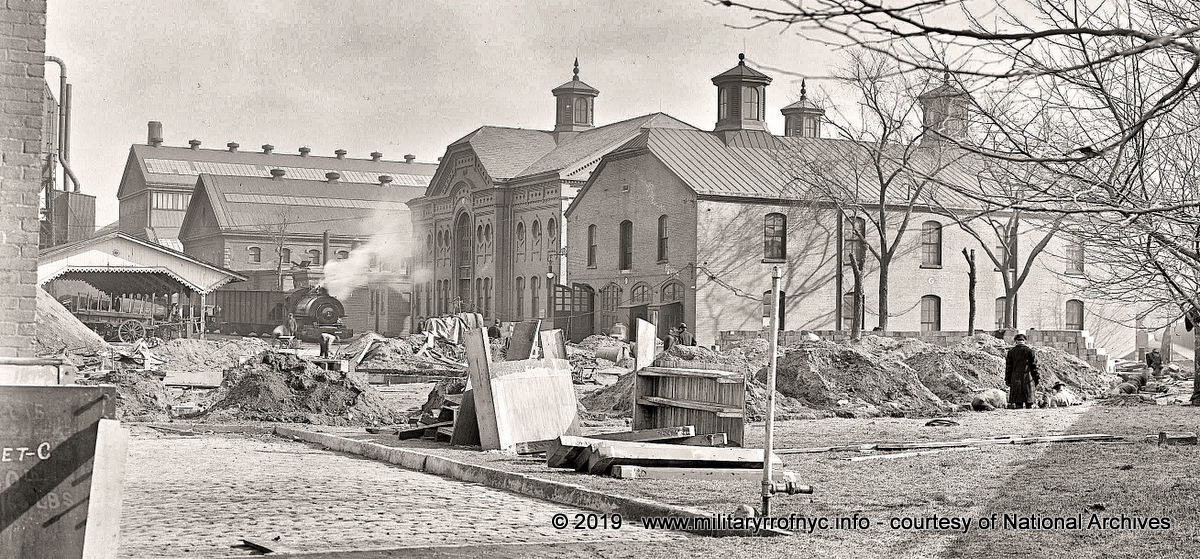 NYNY #1 - January 29, 1916 courtesy National Archives via G. Lane added 01 Aug 2019 | |||||||||||||||||||||||||||||||||||||||||||||||||||||||||
| .
. | |||||||||||||||||||||||||||||||||||||||||||||||||||||||||
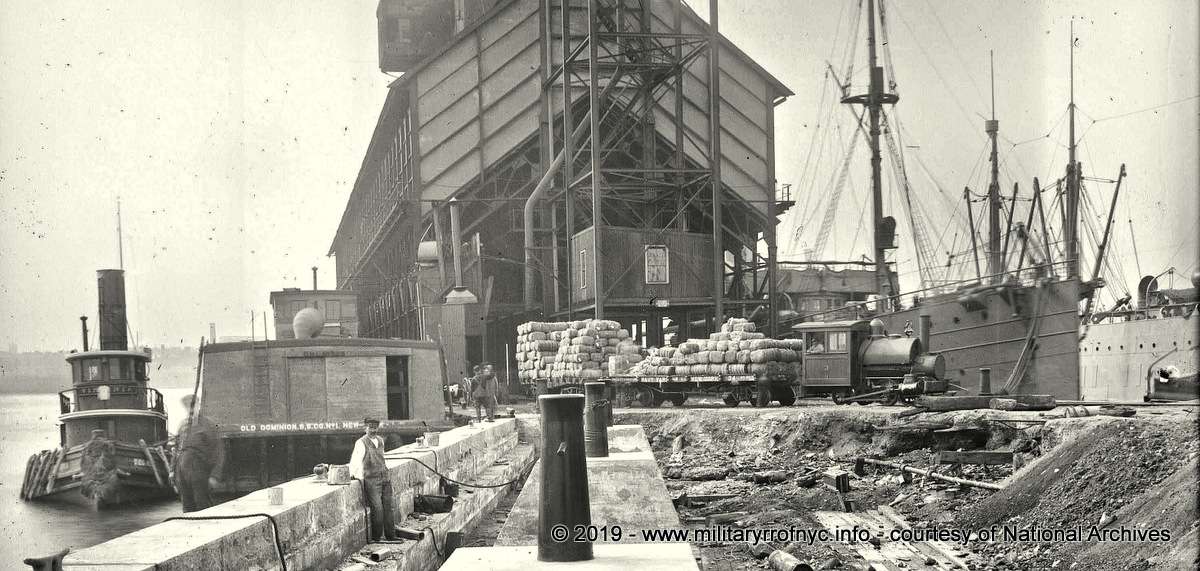 NYNY #3 - Pier G (Coaling) April 27, 1911 courtesy National Archives via G. Lane added 01 Aug 2019 | |||||||||||||||||||||||||||||||||||||||||||||||||||||||||
| .
. | |||||||||||||||||||||||||||||||||||||||||||||||||||||||||
 indeterminate 0-4-0T (possibly "Bee" or "Hercules") - January 6, 1913 courtesy National Archives via G. Lane added 01 Aug 2019 | |||||||||||||||||||||||||||||||||||||||||||||||||||||||||
| .
. | |||||||||||||||||||||||||||||||||||||||||||||||||||||||||
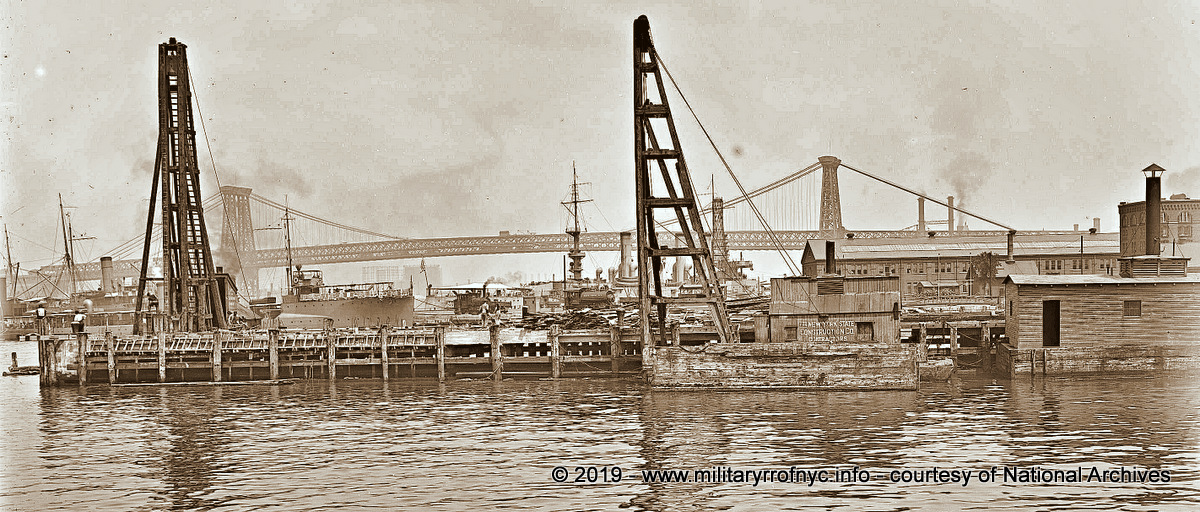 appears to be NYNY #3 (2-4-2T) and indeterminate 0-4-0T - Pier H - July 30, 1913 courtesy National Archives via G. Lane added 01 Aug 2019 | |||||||||||||||||||||||||||||||||||||||||||||||||||||||||
| .
. |
|||||||||||||||||||||||||||||||||||||||||||||||||||||||||
|
|||||||||||||||||||||||||||||||||||||||||||||||||||||||||
| .
. | |||||||||||||||||||||||||||||||||||||||||||||||||||||||||
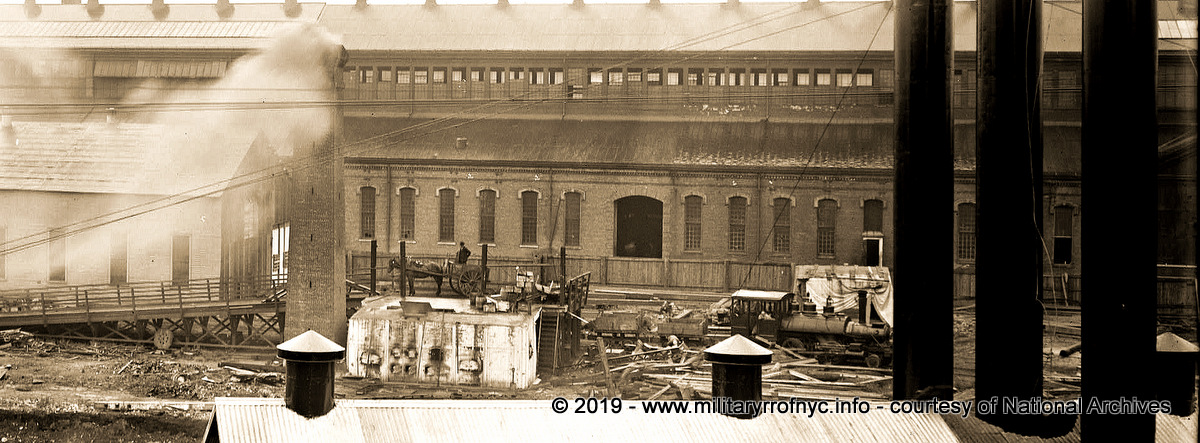 NYNY #3 (2-4-2T) - 1908 Brooklyn Navy Yard Railway locomotive No. 3 Note rear bunker fully enclosed. courtesy National Archives via G. Lane added 01 Aug 2019 | |||||||||||||||||||||||||||||||||||||||||||||||||||||||||
| .
. | |||||||||||||||||||||||||||||||||||||||||||||||||||||||||
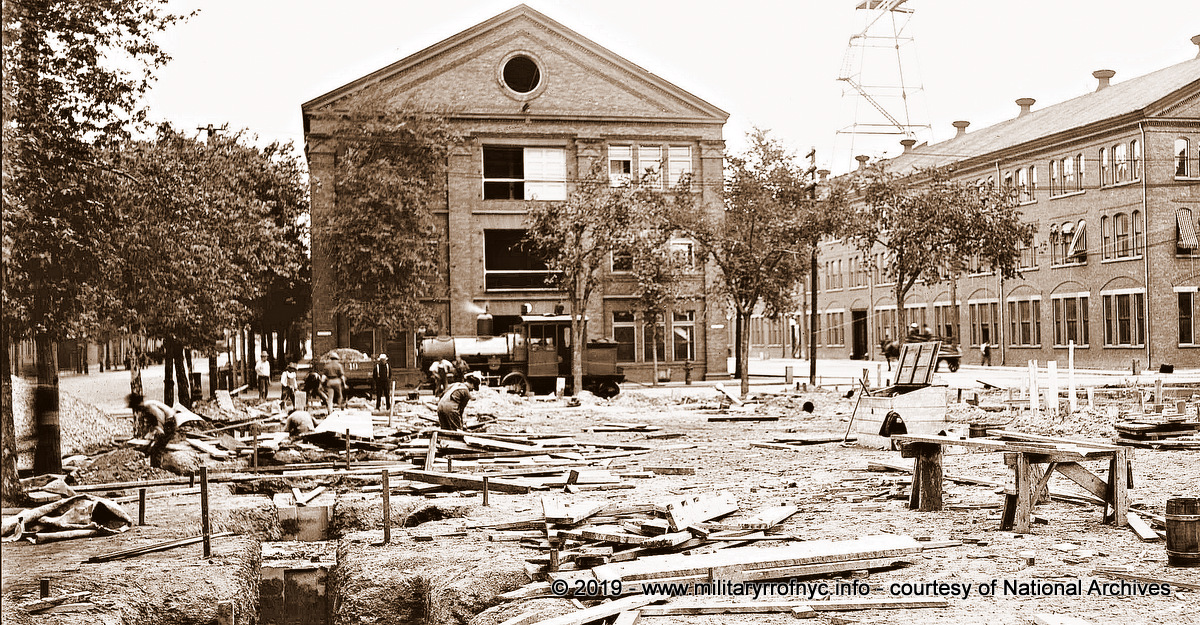 NYNY #4? unknown 0-4-4T - August 1903 "Building 132 and locomotive Brooklyn Navy Yard" This
image poses a dilemma. No known 0-4-4T locomotives are recorded to have
worked at the Brooklyn Navy Yard. courtesy National ArchivesPresumably, it is a surplussed locomotive from the New York Elevated following electrification. via G. Lane added 01 Aug 2019 | |||||||||||||||||||||||||||||||||||||||||||||||||||||||||
| .
. | |||||||||||||||||||||||||||||||||||||||||||||||||||||||||
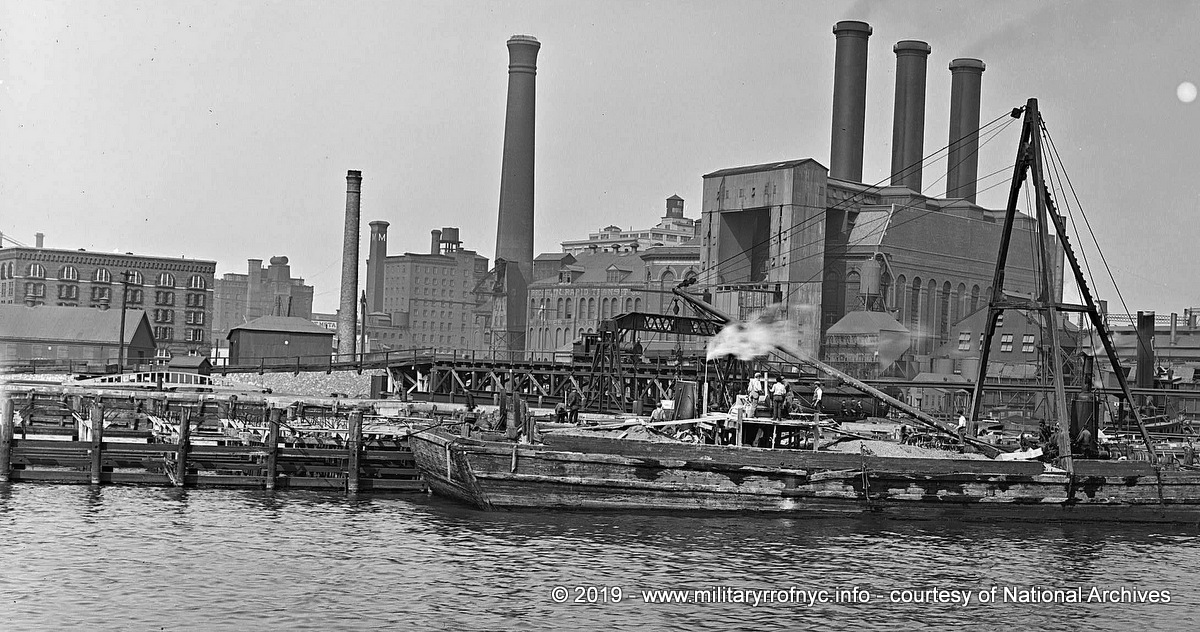 NYNY #4? unknown 0-4-4T - April 19, 1913 "Locomotive on Pier F, NY Navy Yard" Here is that unknown 0-4-4T locomotive again. courtesy National ArchivesPresumably, it is a surplussed locomotive from the New York Elevated following electrification. Also, the description is incorrect. Pier F is the pier in the foreground with the steam lighter. The locomotive is on the scow dump trestle with the "causeway" between. Looking northeast - Brooklyn Rapid Transit powerhouse behind. via G. Lane added 01 Aug 2019 | |||||||||||||||||||||||||||||||||||||||||||||||||||||||||
| .
. | |||||||||||||||||||||||||||||||||||||||||||||||||||||||||
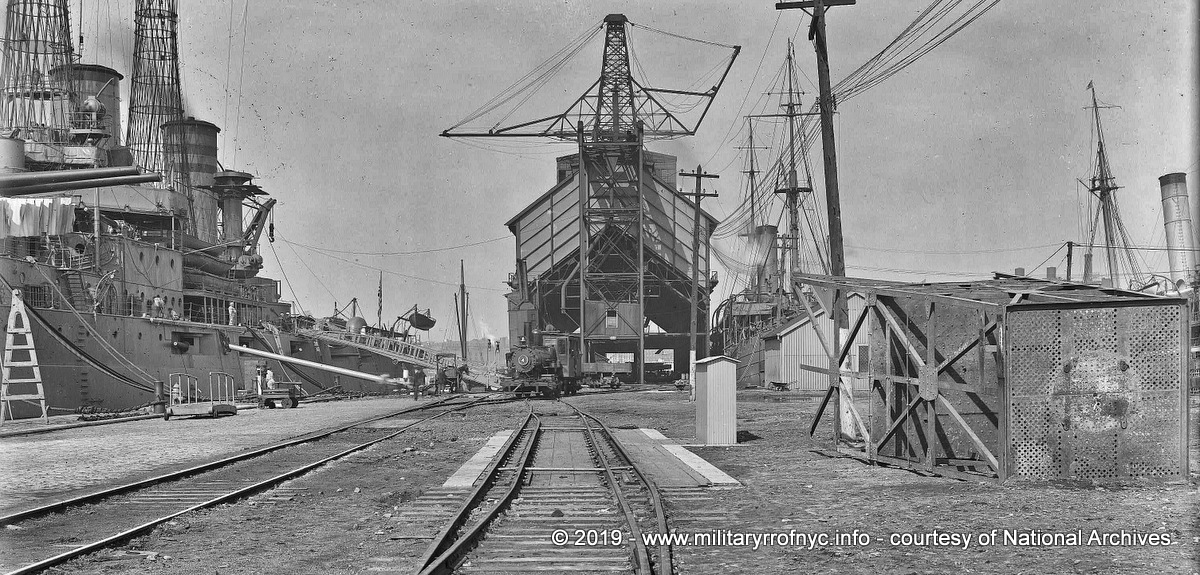 NYNY #4 (0-4-4T) - Pier G (coaling towers) - October 3, 1911 "Brooklyn [New York] Navy Railway Locomotive No, 4 and new track scales" Upon examination, this locomotive appears to be an 0-4-4T. At the time this image is added here, no known 0-4-4T were rostered. Also of interest is the gauntlet track for the scale. It appears the right set of rails is scaled (evidenced by the breaks seen in rail) and the left set (straight) not scaled. courtesy National Archives via G. Lane added 01 Aug 2019 | |||||||||||||||||||||||||||||||||||||||||||||||||||||||||
| .
. | |||||||||||||||||||||||||||||||||||||||||||||||||||||||||
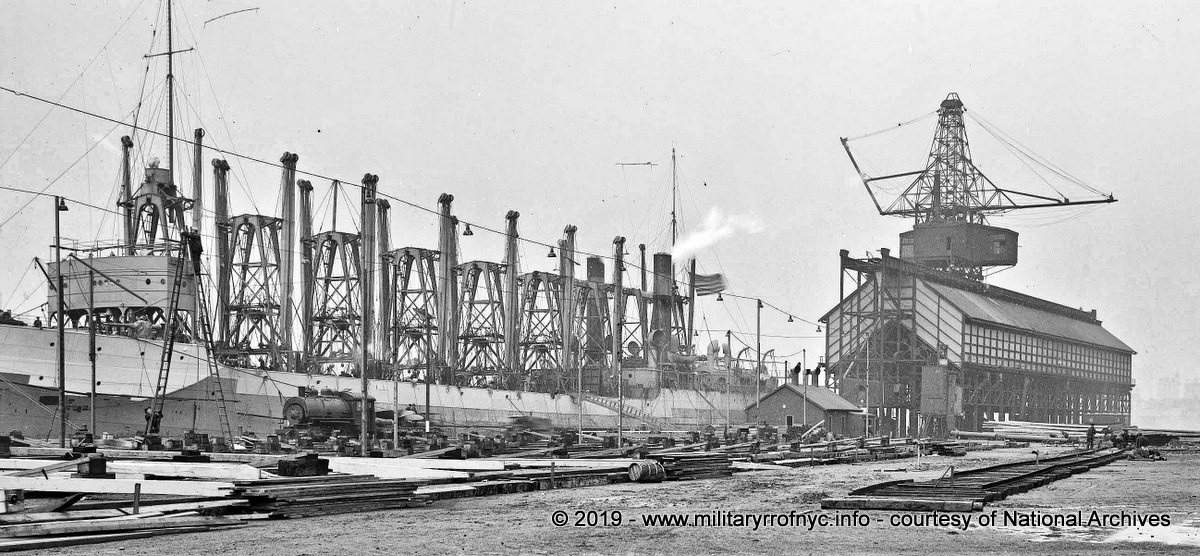 indeterminate 0-4-0T - Pier G - May 1917 Note propeller on flat car trailing locomotive. courtesy National Archives via G. Lane | |||||||||||||||||||||||||||||||||||||||||||||||||||||||||
| .
. |
|||||||||||||||||||||||||||||||||||||||||||||||||||||||||
|
|||||||||||||||||||||||||||||||||||||||||||||||||||||||||
| .
. |
|||||||||||||||||||||||||||||||||||||||||||||||||||||||||
|
|||||||||||||||||||||||||||||||||||||||||||||||||||||||||
| .
. |
|||||||||||||||||||||||||||||||||||||||||||||||||||||||||
|
|||||||||||||||||||||||||||||||||||||||||||||||||||||||||
| .
. |
|||||||||||||||||||||||||||||||||||||||||||||||||||||||||
|
|||||||||||||||||||||||||||||||||||||||||||||||||||||||||
| .
. |
|||||||||||||||||||||||||||||||||||||||||||||||||||||||||
|
|||||||||||||||||||||||||||||||||||||||||||||||||||||||||
| .
. |
|||||||||||||||||||||||||||||||||||||||||||||||||||||||||
|
|||||||||||||||||||||||||||||||||||||||||||||||||||||||||
| .
. |
|||||||||||||||||||||||||||||||||||||||||||||||||||||||||
|
|||||||||||||||||||||||||||||||||||||||||||||||||||||||||
| .
. |
|||||||||||||||||||||||||||||||||||||||||||||||||||||||||
|
|||||||||||||||||||||||||||||||||||||||||||||||||||||||||
| .
. |
|||||||||||||||||||||||||||||||||||||||||||||||||||||||||
|
|||||||||||||||||||||||||||||||||||||||||||||||||||||||||
| .
. |
|||||||||||||||||||||||||||||||||||||||||||||||||||||||||
|
|||||||||||||||||||||||||||||||||||||||||||||||||||||||||
| .
. |
|||||||||||||||||||||||||||||||||||||||||||||||||||||||||
|
|||||||||||||||||||||||||||||||||||||||||||||||||||||||||
| .
. |
|||||||||||||||||||||||||||||||||||||||||||||||||||||||||
|
|||||||||||||||||||||||||||||||||||||||||||||||||||||||||
| .
. |
|||||||||||||||||||||||||||||||||||||||||||||||||||||||||
|
|||||||||||||||||||||||||||||||||||||||||||||||||||||||||
.
. |
|||||||||||||||||||||||||||||||||||||||||||||||||||||||||
|
|||||||||||||||||||||||||||||||||||||||||||||||||||||||||
| .
. |
|||||||||||||||||||||||||||||||||||||||||||||||||||||||||
|
|||||||||||||||||||||||||||||||||||||||||||||||||||||||||
| .
. |
|||||||||||||||||||||||||||||||||||||||||||||||||||||||||
|
|||||||||||||||||||||||||||||||||||||||||||||||||||||||||
| .
. |
|||||||||||||||||||||||||||||||||||||||||||||||||||||||||
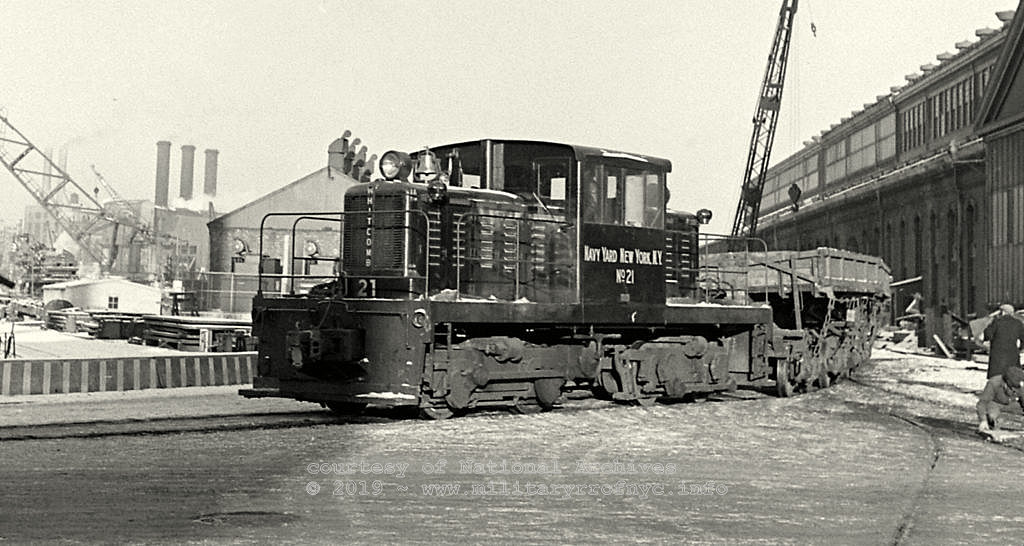 #21 - 1942 photo courtesy of National Archives George Strock photo added 26 May 2019 | |||||||||||||||||||||||||||||||||||||||||||||||||||||||||
| .
. | |||||||||||||||||||||||||||||||||||||||||||||||||||||||||
|
|||||||||||||||||||||||||||||||||||||||||||||||||||||||||
| .
. |
|||||||||||||||||||||||||||||||||||||||||||||||||||||||||
| Upon the
purchase of several photographs of Brooklyn Eastern District Terminal
locomotives, I acquired a series of images taken by Alfred
Jaeger.
For several years, I had been troubled over the identification and purpose of a centercab switcher of B-B wheel arrangement and siderods on BEDT property, which is barely visible in four pictures that I acquired from the A. Jaeger collection. These photos are dated February 19, 1961: (photos enlarged and cropped to show loco in question)
After having placed this dilemma on the back burner for a while; I once again took out my high power loupe and tried to identify this engine again. This time I enlisted the assistance of my good friend and co-author, Paul Strubeck. We argued over builders, but eventually discovered it was a Whitcomb locomotive. One of the pictures was at just the right angle (third from left) to show the nose and the Whitcomb name on the front grill. Then inevitably, came more arguing: which model Whitcomb? With many thanks to North East Rails' Whitcomb pages, Paul and I determined this locomotive was either a 45DE27B or a 45DE28. After a little more debating, we finally settled on 45DE27B. Now for the next argument: who in the New York area would have had a Whitcomb loco? Was it an temporary Bush Terminal, New York Dock, or Bronx Terminal unit? A loaner or demonstrator? Or was it just passing through, being shipped from one place or another? (One thing was sure: it certainly was not a BEDT locomotive!) Then, after Paul Strubeck & I discussed it for about 15-20 minutes... It dawned on us... THE BROOKLYN NAVY YARD. A check of my Whitcomb builders records, showed several Whitcomb Brooklyn Navy Yard entries for both 45DE27B and 45DE28 units. These locomotives was part of multiple orders from the US Navy for Whitcomb units, with other units going to Brooklyn Navy Yard, and the other units going to other Navy Yards & Military Facilities around the US.
The Whitcomb Builders Records sent to
me by Allen Stanley show the locomotives going to the Brooklyn Navy Yard
as:
Then in late 2009, I commenced on rescanning my collection to place larger images on this website. When I got to the one of Alfred Jaeger photos of #16, I realized that the USN Whitcomb locomotive was in one of the photos, and even showed the side of the cab with lettering! This is the right most photo above. But, upon finding the image and looking at the number, I now understand that the conclusion that Paul and I came to in regard to this locomotive being a 45DE27B could be wrong. Upon some scanning and enlarging on the cab seen in the last of the four photos above, yielded this result:
The four images above are at different magnification and resolutions, with the last two being the same except for contrast and notation. Now, I can definitely make out the USN 65-00. It appears that the bottom half of the 1 is missing, but by the spacing to the next digit, (a 6); it is in fact a 1, making the number 65-0016_. The last number is where the question lies: To me it appears to be a 5 or possibly a 6, making the number 65-00165 or 65-00166. Either of these numbers make this locomotive a 45DE28. If that last number by chance is a 9, then it is a 45DE27B. Now, see that light square above the number? That is the original two digit number painted over. Since only the original order of 45DE28's received the two digit numbers 20, 21, 22; and subsequent locomotives received the 65-00xxx series seven digit numbers, 65-00169 (the 45DE27B) would not have had the original two digit number "painted over". Therefore, I now feel we are looking at either locomotive #20 / 65-00165 or #21 / 65-00166 which are 45DE28. You draw your own conclusion and decide. Now, most of us know; the BEDT carfloated to and for the Brooklyn Navy Yard. The questions that now remains unanswered is; was this BNY Whitcomb at the Kent Avenue enginehouse for:
If any of you out there know the answer to these questions, please... shoot me an email!
|
.
Brooklyn (New York) Navy Yard Locomotive
Roster
builder |
c/n |
build date |
gauge |
wheel arrangement |
wheel dia |
cylinders |
acquired |
number / name |
previous owner | disposition |
notes |
ref |
| Rhode Island | 861 | 6/1880 | ? | 2-4-2T | 39" | 11" x 16" | used | ex-New York Elevated #276 | sold 5/1898 |
wgt: 42,450 lbs. |
[14] [33] |
|
| Vulcan | 187 | 8/1891 | std. | 0-4-0T | 36" | 10" x 14" | new | "Hercules" | [8] [33] |
|||
| H. K. Porter | 1958 | 1/1899 | std. | 0-4-0 | 9" x 14" | new | "Bee" | [3] | ||||
| Baldwin | 22726 | 8/1903 | std. | 2-4-2T | 42" | 12" x 18" | new | #3 | to Southern Iron & Equipment
#1729, (broker) to T. F. Cary Co.; sold 6/7/1922 to Riverside Lmbr. #1, Beach, GA (as 0-4-2T) |
built new for Yard & Docks, NYNY | [2] [33] |
|
| unknown | ? | 0-4-4T | #4 | possibly New York Elevated | seen in photo on scow dumping trestle, in front of building 132 and on Pier G | |||||||
| H. K. Porter | 2942 | 10/1903 | std. | 0-4-0T | 10" x 14" |
new | ||||||
| H. K. Porter | 3368 | 1/1906 | std. | 0-4-0T | 12" x 16" |
new | ||||||
| Davenport | 499 | 9/1906 | 36" | 0-4-0T | 10" x 16" | used | Holbrook, Cabot & Rollins, PA; used by private contractor in NYNY, | to United Engineering & Construction, Lockport, NY |
[5] [33] |
|||
| Vulcan | 1416 | 11/1909 | std. | 0-4-0T | 37" | 14" x 20" | new | wgt: 70,000 lbs. | [8] [33] |
|||
| Lima | 2214 | 11/1909 | 36" | 24 ton 2 truck Shay |
26½" | 8" x 8" | used? | #1 | [c] Holbrook, Cabot & Rollins Co |
sold: to Moon Lumber Co.; Curtis, WV sold: Ralph H. Ely, Frenchton, WV |
Holbrook, Cabot & Rollins Co Brooklyn Navy Yard, Brooklyn, NY |
[12] |
| Lima | 2258 | 12/18/1909 | 36" | 24 ton 2 truck Shay | 26½" | 8" x 8" | used? | #2 | [c] Holbrook, Cabot & Rollins Co | sold: Cherry River Extract Co., Palmer, WV sold: Camp Run Lumber Co., |
Holbrook, Cabot & Rollins Co., #2, Brookfield | [12] |
| Lima | 2259 | 12/21/1909 | 36" | 24 ton 2 truck shay | 26½" | 8" x 8" | used? | #3 | [c] Holbrook, Cabot & Rollins Co |
sold 12/1918: Berry &
Waggy, #1, sold ca. 3/1923: Moon Lumber sold: Camp Run Lumber Co., #3, sold ca. 6/1928: Morrison-Gross & Co., #3, for sale 8/1935 | Holbrook, Cabot & Rollins Co., #3, Brookfield | [12] |
| Davenport | 1014 | 4/1910 | 36" | 0-4-0T | 9" x 14" | new | [c] Holbrook, Cabot & Rollins Co | to Moran Towing & Transport, Brooklyn, NY | [5] [33] |
|||
| ALCo | 56439 | 2/1917 | std. | 0-4-0T | 14" x 22" | new | #6 | wgt: 152,000 lbs. | [1] | |||
| Vulcan | 2644 | 4/1917 | std. | 0-4-0T | 37" | 14" x 20 | new | #7 | to: The Foundation Co., Racine,
Quebec, 1/31/1942; to: American Creosote Co. #7, Jackson, TN, 2//4/1942; currently at Illinois RR Museum since 1971, under restoration |
wgt: 78,000 lbs. l: 27' w: 9' 4" h: 11' 4" t.e.: 16,200 lbs. BR&L list shows this as USN #2 Brooklyn Navy Yard |
[8] [7] [36] |
|
| ALCo | 55816 | 5/1917 | std. | 0-4-0T | 12" x 18" | new | #8 | wgt: 101,000 lbs. | [1] [33] |
|||
| Vulcan | 2677 | 8/1917 | std. | 0-4-0T | 37" | 14" x 20" | new | #9 | to: T. F. Carey (broker) to: The Foundation Co., Racine, Quebec 10/10/1941 |
BR&L records shows this as USN #1 Brooklyn Navy Yard | [8] [7] [33] |
|
| ALCo | 56974 | 8/1917 | std. | 0-4-0T | 14" x 22" |
#10 | wgt: 152,000 lbs. | [1] [33] |
||||
| ALCo | 56994 | 12/1917 | std. | 0-4-0T | 12" x 18" | #11 | wgt: 101,000 lbs. | [1] [33] |
||||
| Vulcan | 2822 | 7/1918 | 36" | 0-4-0T | new | [c] | for Holbrook, Cabot & Rollins Co.,? | [8] | ||||
| Vulcan | 2854 | 9/1918 | std. | 0-4-0ST | 42" | 15" x 24" | new | #12 | sold 5/1947 to Dexter & Northern
#12, Dexter, NY; sold to Abe Cooper, Watertown, NY; to Bob Smith; to Tioga Transportation Museum; to Rochester & Genesee Valley RR Museum, on display sold 11/2022 to S. Symans (for eventual operational restoration. |
wgt:
90,000 lbs. [a] |
[8]} [33] |
|
| Vulcan | 2865 | 10/1918 | std. | 0-4-0T | 42" | 15" x 24" | new | #13 | sold to Harrisburg Pipe & Bending,
new VIW boiler 11/1940; sold 6/1942 to Hammond Coal, Girardville, PA |
wgt: 90,000 lbs. | [8] [33] |
|
| H. K. Porter | 7208 | 4/1934 | std. | 0-4-0FG | 41" | 16" x 16" | new | #14 | to Newport Chemical, #60, Oakdale, LA; scrapped 1966 |
60T Fireless Gear Timken Bearings |
[3] [33] |
|
| Vulcan | 4249 | 12/1938 | std. | B | new | #15 | sold 4/1948 to Cacchette & Sons, Sunbury, ONT | spur gear drive 30T - 175 hp - D/M wgt: 62,500 lbs. |
[8] [33] |
|||
| Atlas |
2182 |
8/1940 |
std. |
B-B |
new |
#16 |
2/1948: to USN Supply Depot; Bayonne, NJ to American Aggregate Corp, New Miami, OH |
class E4625 50T - 300 hp - D/E wgt: 100,000 lbs. |
[13] | |||
| Vulcan |
4309 |
6/1941 |
std. |
0-4-0T | #2025 | New Hope Valley Rwy & NC Railroad Museum, New Hill, NC | listed in builders records as NY Shipbuilding (Camden, NJ), but used at USN Yard, NY; Carbon Limestone #17, Carbon, PA; WV Northern RR #17; |
[8] [33] |
||||
| H. K. Porter | 7314 | 7/1941 | std. | B-B | new | #18 #65-00466 |
sold 2/3/1959 to B. M. Weiss & Co.
(dealer); to Equip Co .of America (dealer); to Union Carbine ca. 1971 via Long Island Equip.; to Elkem Metals; at Historic Harmar Bridge Co, OH |
45T - 300 hp - D/E wgt: 90,000 lbs. |
[3] [37] [33] [b] |
|||
| H. K. Porter | 7315 | 7/1941 | std. | B-B | new | #65-00163 | transferred 7/7/1950 to Naval Reserve
Shipyard, Kearny, NJ; moved back to Brooklyn unknown date; sold 1/27/1960 to Equipment Co. of America, but stored in Bklyn. for sale ca. 1961-62. Trucks sold to Striegel Supply & Equip, Baltimore MD. remainder scrapped (another report states loco was sold for scrap 1/27/1960) |
45T - 300 hp - D/E wgt: 90,000 lbs. |
[3] [33] |
|||
| H. K. Porter | 7316 | 7/1941 | std. | B-B | new | #65-00164 | sold ca. 1965 to Pittsburgh, Allegheny &
McKees Rocks, #6, rebuilt & re#16; sold 11/25/1975 to Vulcan Detinning, Neville Island, PA |
45T - 300 hp - D/E wgt: 90,000 lbs. |
[3] [37] [33] [b] |
|||
| Atlas | 2295 | 8/1941 | std. | B-B | new | #28 | to USN Supply Depot, Bayonne, NJ, 3/48; to E. Kinney, Elizabeth, NJ; unknown date to American Aggregate Corp, IN, unknown date |
class E6629 50T - 300 hp D/E wgt: 100,000 lbs. |
[13] [33] |
|||
| Whitcomb | 60097 | 10/1941 | std. | B-B | new | #20 #65-00165 |
sold unknown date to Heppenstall Steel Co.,
Pittsburgh, PA; MCP Co., Pittsburgh, PA; Durabond Protective Coatings, Export, PA; Durabond Protective Coatings, Allentown, PA; Jersey Shore Steel, Avis, PA; seen burnt out 12/69? |
45DE28 45T - 300hp wgt: 90,000 lbs. |
[13] [34] [33] |
|||
| Whitcomb | 60098 | 10/1941 | std. | B-B | new | #21#65-00166 | P.W. Duffy (dealer), Columbus, OH | 45DE28 45T - 300hp wgt: 90,000 lbs. |
[13] | |||
| Whitcomb | 60099 | 10/1941 | std. | B-B | new | #22 #65-00167 |
sold 4/1960? to Alter Scrap, Bridgeport,
CT?; sold 4/60 to J. L. Case, Bettendorf, IA #802; Burlington River Term; to Farmington & Western, Ft. Madison, IA |
45DE28 45T - 300hp wgt: 90,000 lbs. |
[13] [34] [33] |
|||
| H. K. Porter | 7383 | 6/1942 | std. | B-B | new | #? | to Bethlehem Steel | 44T | [3] | |||
| Whitcomb | 60165 | 9/1942 | std. | B-B | new | #65-00170 | sold 1962, to Pittsburgh Allegany &
McKees Rock #5; scrapped ca. 1976 |
45DE28A 45T - 300hp wgt: 90,000 lbs. |
[13] [33] |
|||
| Whitcomb | 60219 | 3/1943 | std. | B-B | new | #65-00168 | built for Missouri Portland Cement, St. Louis MO; diverted at Whitcomb to BNY; transferred to N.A.S. @ Quonset Pt. RI and for sale there ca. 1/1968 | 50DE58A 50T - 300hp wgt: 100,000 lbs. |
[13] [34] [33] |
|||
| Whitcomb | 60325 | 8/1943 | std. | B-B | new | #65-00169 | transferred to Navy
Yard Philadelphia, PA; to US Army Ammo plant, Burlington,
NJ; for sale on 8/1968; to Guyon Pipe & Valve, Harrison, NJ; to Wolfsboro RR #67, Wolfsboro, NH; to Brummer Car #67, Renovo, PA |
45DE27B 45 T - 300hp wgt: 90,000 lbs. |
[13] [34] [33] |
|||
| Whitcomb | 60326 | 6/1944 | std. | B-B | new | #65-00220 or #65-00252 |
45DE27B 50 T - ?hp |
[34] | ||||
| GE | 15038 | 9/26/1942 | std. | B-B | 33" | new | #65-00008 |
|
44 ton Caterpillar D-17000 (x2) 380hp B-B-88/88-4GE733 |
Locomotive Footnotes:
[a] = Thanks to the R&GV RR Museum website, this is known about BNY #12:
| built: | 1918 | Vulcan Loco Works, Wilkes Barre, PA |
| new boiler: | 1931 | Brooklyn Navy Yard |
| end of service (BNY): | ca. 1947 | went to Dexter & Northern RR |
| new flues: | 1955 | New York Central (contracted out) |
| ca. 1970 | to Amusement Park, Owego, NY | |
| 1971 - 1991 | to Tioga Transportation Museum, Flemingville, NY | |
| 1997 | to Rochester & Genesee Valley Railroad Museum |
(dates courtesy of R&GV website)
[b] = photos of these locomotives in their post US Navy liveries can be viewed at: NorthEast Rails Porter 25-45T Industrial Railroad Locomotives
[c]
= these three
Shay locomotives and narrow gauge 0-4-0T's may not have been
actually part of the New York Naval Shipyard locomotive roster and may
have only been on site for the expansion of the Shipyard.
All locomotives highlighted in brown
appear to have been purchased by Holbrook Cabot & Rollins, and of
whom was awarded the contract at the Navy Yard. After completion of the
work, the locomotives were sold off.
Readers, please note:
Brooklyn Eastern District Terminal #12 and and #13 (H. K. Porter c/n 6368 and 6369 respectively) were NOT used at the Brooklyn Navy Yard prior to purchase by the Brooklyn Eastern District Terminal, but were in fact used at the Fleet Supply Base - South Brooklyn Section, a separate U. S. Navy installation and were part of a four locomotive order of consecutive construction numbers: 6366, 6367, 6368, 6369 for that installation. Therefore these locomotives are not listed in the roster above.
At the current time, disposition of Fleet Supply Base #1 and #2 (H. K. Porter c/n's 6366 and 6367) is unknown at the current time, and information on these locomotives is welcome here. Information, specifications and images may be viewed here: Fleet Supply Base - South Brooklyn Section.
.
..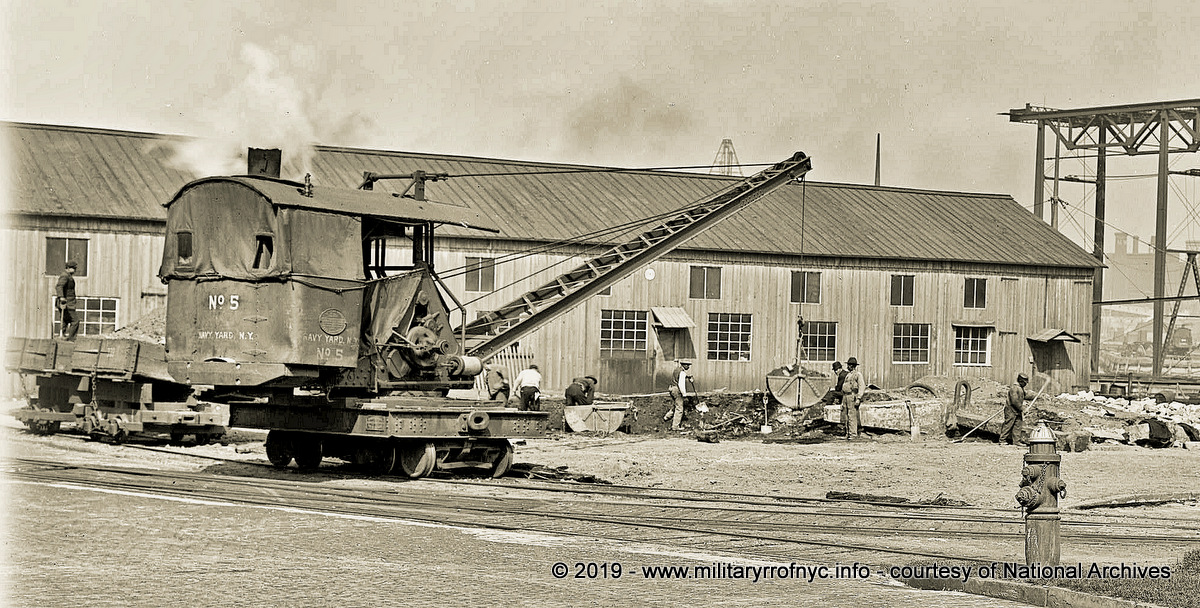
Brooklyn (New York) Navy Yard Railway Crane Roster
builder |
c/n |
model | build date |
gauge |
wheel arrangement |
capacity | boom | power |
acquired |
disposition |
notes |
ref |
| Browning | 1145 | 1913 | std. | 50 ton | new | [56] | ||||||
| Browning | 1662 | #8 | 1918 | std. | B-B | 19 ton | new | [56] | ||||
| Browning | 1663 | #8 | 1918 | std. | B-B | 19 ton | new | [56] | ||||
| Browning | 1664 | #8 | 1918 | std. | B-B | 19 ton | new | [56] | ||||
| Browning | 1665 | #8 | 1918 | std. | B-B | 19 ton | new | [56] | ||||
| Ohio Locomotive Crane | 4032 | F | 6/16/1939 | std. | B-B | 30 tons | 70' | gasoline | new | [56] | ||
| Ohio Locomotive Crane | 4033 | F | 7/21/1939 | std. | B-B | 30 tons | 50'-70' | new | [56] | |||
| Ohio Locomotive Crane | 4060 | F | 4/15/1941 | std. | B-B | 30 tons | 75' +5' | diesel | new | [56] | ||
| Ohio Locomotive Crane | 4061 | F | 4/30/1941 | std. | B-B | 30 tons | 75' +5' | diesel | new | returned to Bucyrus and rebuilt to Kasle Steel Compressing, Springfield, OH 6/5/1969 |
[56] | |
| Ohio Locomotive Crane | 4062 | F | 5/9/1941 | std. | B-B | 30 tons | 75' +5' | diesel | new | to Mayer Pollock, Pottstown, PA; 1953 | [56] | |
| Ohio Locomotive Crane | 4155 | F | 4/21/1942 | std. | B-B | 30 tons | 75' +5' | diesel | new | [56] | ||
| Ohio Locomotive Crane | 4156 | F | 5/12/1942 | std. | B-B | 30 tons | 75' +5' | diesel | new | Equipment Corp. of America; Aldan, PA; Tidewater Equipment Co. Chesapeake, VA; 1965 |
[56] | |
| Ohio Locomotive Crane | 4157 | F | 6/30/1942 | std. | B-B | 30 tons | 75' +5' | diesel | new | Mayer Pollock, Pottstown, PA | [56] | |
| Ohio Locomotive Crane | 4235 | F | 7/19/1942 | std. | B-B | 30 tons | 50'-65' +5' | diesel | new | [56] | ||
| Ohio Locomotive Crane | 4236 | F | 7/31/1942 | std. | B-B | 30 tons | 50'-65' +5' | diesel | new | |||
| Ohio Locomotive Crane | 4248 | F | 2/12/1943 | std | B-B | 30 tons | 75' +5' | diesel | new | |||
| Ohio Locomotive Crane | 4249 | F | 2/26/1943 | std. | B-B | 30 tons | 75' +5' | diesel | new | Clark Brothers. Olean, NY; 1960 | ||
| Ohio Locomotive Crane | 4250 | F | 3/6/1943 | std. | B-B | 30 tons | 75' +5' | diesel | new | Franklin Smelting & Refining Co; Philadelphia, PA; 1964 | ||
| Ohio Locomotive Crane | 4251 | F | 2/27/1943 | std. | B-B | 30 tons | 75' +5' | diesel | new | Mayer Pollock, Pottstown, PA | ||
| Ohio Locomotive Crane | 4252 | F | 3/9/1943 | std. | B-B | 30 tons | 75' +5' | diesel | new | |||
| Ohio Locomotive Crane | 4253 | F | 3/12/1943 | std. | B-B | 30 tons | 75' +5' | diesel | new | |||
| Ohio Locomotive Crane | 4261 | F | 3/16/1943 | std. | B-B | 30 tons | 75' +5' | diesel | new | |||
| Ohio Locomotive Crane | 4262 | F | 3/17/1943 | std. | B-B | 30 tons | 75' +5' | diesel | new | |||
| Ohio Locomotive Crane | 4263 | F | 3/19/1943 | std. | B-B | 30 tons | 75' +5' | diesel | new | Mayer Pollock, Pottstown, PA | ||
| Ohio Locomotive Crane | 4305 | F | 6/15/1943 | std. | B-B | 30 tons | 50'-70' +5 | diesel | new |
.
Index:
Military
Railroads of the New York Metropolitan AreA | ||||
| EARLE N.A.D. N.W.S. EARLE | ||||
| FORT TOTTEN | Fort Terry | Fort Hancock / SANDY HOOK PROVING GROUNDS | ||
| . SIGN THE GUESTBOOK | ||||
.